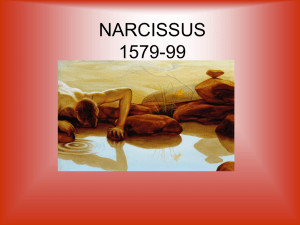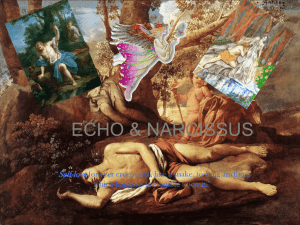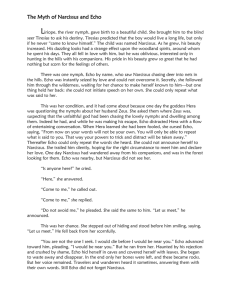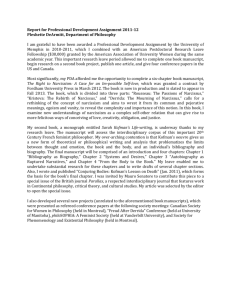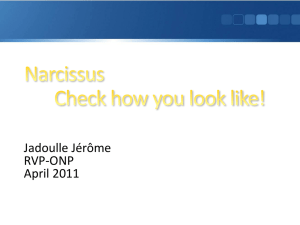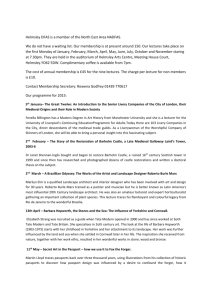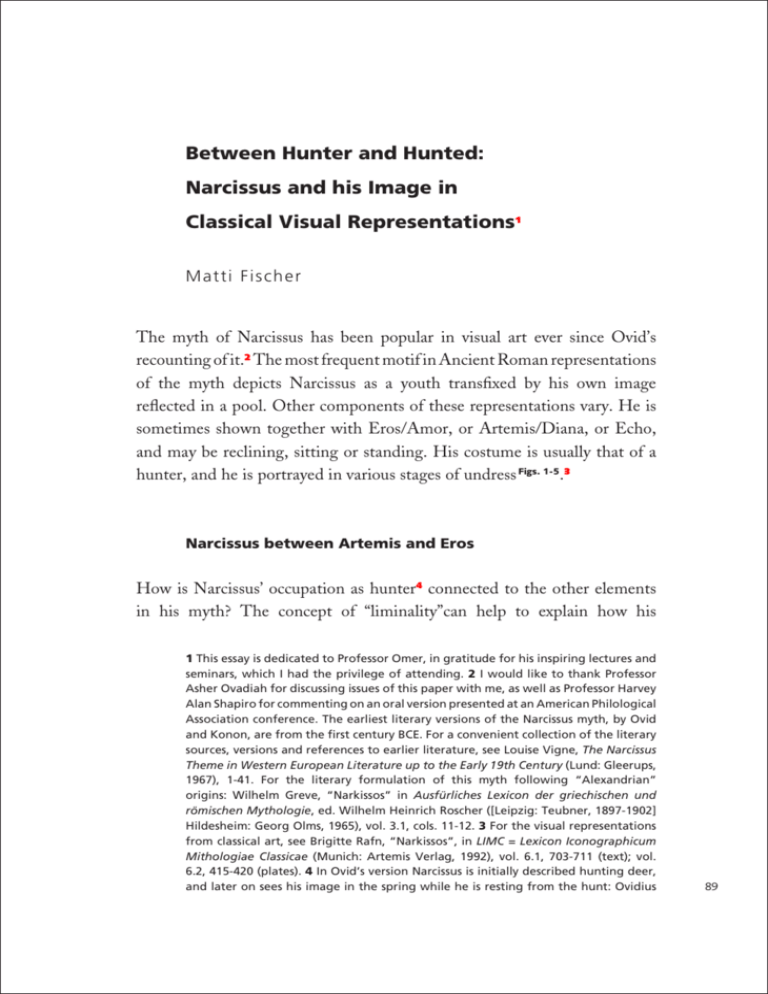
Between Hunter and Hunted:
Narcissus and his Image in
Classical Visual Representations1
Ma t t i F i s c h e r
The myth of Narcissus has been popular in visual art ever since Ovid’s
recounting of it.2 The most frequent motif in Ancient Roman representations
of the myth depicts Narcissus as a youth transfixed by his own image
reflected in a pool. Other components of these representations vary. He is
sometimes shown together with Eros/Amor, or Artemis/Diana, or Echo,
and may be reclining, sitting or standing. His costume is usually that of a
hunter, and he is portrayed in various stages of undress Figs. 1-5.3
Narcissus between Artemis and Eros
How is Narcissus’ occupation as hunter4 connected to the other elements
in his myth? The concept of “liminality”can help to explain how his
1 This essay is dedicated to Professor Omer, in gratitude for his inspiring lectures and
seminars, which I had the privilege of attending. 2 I would like to thank Professor
Asher Ovadiah for discussing issues of this paper with me, as well as Professor Harvey
Alan Shapiro for commenting on an oral version presented at an American Philological
Association conference. The earliest literary versions of the Narcissus myth, by Ovid
and Konon, are from the first century BCE. For a convenient collection of the literary
sources, versions and references to earlier literature, see Louise Vigne, The Narcissus
Theme in Western European Literature up to the Early 19th Century (Lund: Gleerups,
1967), 1-41. For the literary formulation of this myth following “Alexandrian”
origins: Wilhelm Greve, “Narkissos” in Ausfürliches Lexicon der griechischen und
römischen Mythologie, ed. Wilhelm Heinrich Roscher ([Leipzig: Teubner, 1897-1902]
Hildesheim: Georg Olms, 1965), vol. 3.1, cols. 11-12. 3 For the visual representations
from classical art, see Brigitte Rafn, “Narkissos”, in LIMC = Lexicon Iconographicum
Mithologiae Classicae (Munich: Artemis Verlag, 1992), vol. 6.1, 703-711 (text); vol.
6.2, 415-420 (plates). 4 In Ovid’s version Narcissus is initially described hunting deer,
and later on sees his image in the spring while he is resting from the hunt: Ovidius
89
M at t i Fi s c her
[1]
[2]
[1] Narcissus in a languid diagonal pose, mid-1st century CE, wall painting
from Pompeii, House of Lucretius Frontus. [2] Narcissus in an active pose
(lower center) in a detail from the Megalopsychia Mosaic, Antioch, 5th
century CE. Musée Archéologique du Hatay, Antakya.
occupation and clothing play an important role in this myth and especially
in its visual representations. Victor Turner defines liminality as a state of
transition between two stable states of existence, usually encountered in
rites of passage. In the liminal state the person is subject to “middle ground
ambiguity” – he is “neither-nor” or “both this and that”, a state sometimes
indicated symbolically as role reversal.5 For example: a male/female reversal,
Naso, Metamorphoses, trans. Frank Justus Miller (Loeb Classical Library, London and
Cambridge, Mass.: William Heinemann and Harvard University Press, 1984), Book 3, ll.
356, 413 (pp. 146, 148). In Pausanias’ version he and his sister had used to go hunting
together. Pausanias, Description of Greece, trans. W.H.S. Jones (Loeb Classical Library,
London and Cambridge, Mass.: William Heinemann and Harvard University Press,
1955), Book IX, 31.7-9 (311). In a note on Statius’ Thebais that perhaps derives from
Hyginus, Narcissus is described as an “eager hunter” (uenandi studiosus); see Vigne,
The Narcissus Theme, 23, for both the source and a translation. For other sources see
Greve, “Narkissos”. 5 Turner describes neophytes in the liminal phase as “neither
living nor dead from one aspect, and both living and dead from another”, Victor
Turner, The Forest of Symbols (Ithaca: Cornell University Press, 1967), 96-97. Other
scholars formulate a similar idea: see Edmund Leach, Culture and Communication
(Cambridge: Cambridge University Press, 1976), 77-82, esp. the diagram on p. 82,
“Liminal zone ‘both A and not-A’“, and, following him, Hoffmann, who uses the
term: “middle ground ambiguity”, Herbert Hoffmann, Sexual and Asexual Pursuit,
A Structuralist Approach to Greek Vase Painting (London: Royal Anthropological
Institute of Great Britain and Ireland, 1977), 2.
[4]
[3]
[3] Narcissus, with rounded breasts, removing his mantle. 1st century
CE (Vespasianic), wall painting from Pompeii. Museo Archeologico
Nationale, Naples. [4] Narcissus with curved body form, standing with
arms behind his head, detail from a sarcophagus, late 2nd century CE.
Galleria Lapidaria, Vatican Museum.
sometimes expressed in terms of clothing, may occur in the liminal stage of
the rites of transition from youth to adulthood. The story of Achilles being
dressed as a girl at Scyros, and rituals in which young girls were dressed as
soldiers (hoplitai), are instances of this.6
Both hunting and erotic pursuit can be seen as transitional situations.
As Alain Schnapp says: “The world of the Hunt, like that of the Erotic, is
a space in which anything may happen and the hunter becomes the game,
like Actaeon devoured by his hounds”.7 Stating this in terms of liminality,
hunting may be understood as a liminal situation of encounter with an
“Other”. In the hunting context the Other is the animal; in the erotic
context it is the beloved.
6 On transition and participation-in-the-opposite between male and female during
transition from youth to adulthood, see: Jean-Pierre Vernant, Myth and Society in
Ancient Greece, trans. Janet Lloyd (New York: Zone Books, 1988), 34-35, and Pierre
Vidal-Naquet, “Recipes for Greek Adolescence”, in Myth, Religion and Society, ed.
Richard L. Gordon (Cambridge: Cambridge University Press, 1981), 172; Pierre VidalNaquet, “The Black Hunter and the Origin of the Athenian Ephebeia”, in Gordon
(ed.), Myth, Religion and Society, 162. 7 Alain Schnapp, “Eros the Hunter”, in A City
of Images, ed. Claude Bérard, Christiane Bron, Jean-Louis Durand and others, trans.
Deborah Lyons (Princeton: Princeton University Press, 1989), 72.
91
M at t i Fi s c her
[5]
[6]
[5] Narcissus on a carnelian ringstone with Artemis/Diana in the
background as a statuette on a pillar, 1st century CE. Cabinet des
Médailles, Paris. [6] Endymion in a languid diagonal pose with one arm
behind his head, mid-1st century CE wall painting from Pompeii.
Hunting is the domain of the goddess Artemis, whom Jean-Pierre
Vernant views as the goddess of the “border” zones of encounter with the
Other.8 Artemis presides over the transition of youths into adults. The
liminal situation in these transitional rites, is indicated by the interaction of
youth and animal.
As I will show, the myth of Narcissus, as presented in visual terms,
relates to transformation from youth to adulthood. This is indicated by
representing Narcissus as a young hunter who refuses to fall in love, who
indeed is adverse to love. On the other hand, the theme of hunting is often
perceived as a metaphor for “love”. This metaphor is manifested in instances
of figures in hunter’s attire shown pursuing their beloved. The gift to the
beloved of an animal caught by the lover serves to indicate their relations as
hunter and hunted.9
8 Jean-Pierre Vernant, “The Figure and Function of Artemis in Myth and Cult” in
Mortals and Immortals, ed. Froma Zeitlin (Princeton: Princeton University Press,
1992), 197-198. 9 For examples in the scenes of “Eros” or “Amor” engaged in the
hunt see LIMC, s.v. “Eros/Amor Cupido”, cat. nos. 296-325, and “Eros”, cat. nos. 332-
[7]
[8]
[7] A sleeping maenad being approached by a satyr, 430 BCE, red figure
vase painting. Museum für Vor- und Frühgeschichte, Frankfurt am
Main. [8] Venus with one arm raised to her hair while Mars uncovers her
body, 1st century CE, wall painting from Pompeii. Museo Archeologico
Nationale, Naples.
My emphasis on the iconography of Narcissus as a hunter focuses on an
understanding of hunting as a liminal situation. The possibility of reversal
– from hunter to hunted – inherent in this situation makes it possible to
interpret Narcissus’ physical form and pose and his half-clad body, as well
as his punishment, as “playing” on two antithetical ideas – that of hunting
and loving being mutually exclusive, and that of the hunt-love metaphor.
This punishment eventually takes on the form of transfixion by his beloved
– himself.
Narcissus is usually shown with the attributes of a hunter – chlamys,
petasos or spear.10 The petasos is a broad-brimmed hat associated with
356. For love gifts see examples in Schnapp, “Eros the Hunter”, Fig. 108 (wild game)
and Fig. 113 (a hare held out as a courtship gift). For a love-hunt see Christiane
Sourvinou-Inwood, “A Series of Erotic Pursuits: Images and Meanings”, Journal of
Hellenic Studies, 107 (1987): Plates 2b, 3a, c, d, where armed hunters pursue girls. For
a bearded adult holding a spear and pursuing a young boy (Zeus and Ganymede) see
Harvey Alan Shapiro, “Courtship Scenes in Attic Vase Painting”, American Journal
of Archaeology, 85(1981): Plate 27, Fig. 12. 10 See Rafn, “Narkissos”, vol. 7.1, 710,
who, however, does not mention the chlamys. For illustrations showing Narcissus in
costume see Rafn, “Narkissos”, cat. nos. 1, 3, 6, 9, 10, 11, 28, 32, and LIMC, s.v. “Echo”,
93
M at t i Fi s c her
those who spend much time outdoors, such as hunters or hunter-heroes,
shepherds and voyagers. The chlamys is a short mantle worn by hunters,
soldiers and voyagers. The petasos and the chlamys together were also worn
by Athenian ephebes.11 This outfit thus has a recognized connection with
heroes, hunters and youths, who are also interconnected in the rites of
transition of youth to adulthood, when the young men emulate the heroes
and participate in various forms of hunting.12 The appearance of a statue
of Artemis in some of the representations emphasizes the liminal/ hunting
motif Fig. 5.
The spears that Narcissus is seen holding in several representations
indicate hunting for big game. To the best of my knowledge there is only
one image (in a 5th century CE mosaic) in which Narcissus is shown actively
hunting and using his costume and gear in the manner characteristic of
the regular iconography of a hunter in action Fig. 2.13 Almost all other
representations show his chlamys either not being used as it would be in
action or being removed, while his weapons are either not in use or are not
present at all. His pose, however, is the complete opposite of the hunter’s
cat. no. 13. The costume of a hunter in various representations may change according
to local custom and time, and may sometimes include actual hunting gear, while at
other times only the essential “heroic” hunter’s costume is shown, which includes
the abovementioned equipment but shows the body in the nude (feet may be either
bare or shod in boots, the hat may be a petasos or a pilos). The case is similar in
youthful chases, or the youths may be lightly dressed. For an overview of the costume
of hunters see Paulys Realencyclopädie der Classischen Altertumswissenschaft
(Stuttgart: Alfred Druckenmüller, 1914), s.v. “Jagd”, 567-568. See also Jacques
Aymard, Les chasses romaines (Paris: E. de Boccard, 1951), 202-204; Alain Schnapp, Le
chasseur et la cité (Paris: Albin Michel, 1997), 222-223, 360 with Figs. 198, 202, 220, 223,
408; See also Christiane Sourvinou-Inwood, “A Series of Erotic Pursuits”, 134-135. In
general Narcissus is shown with the heroic costume, which includes some or all of the
equipment mentioned. It is a distinctly Greek costume, even when these depictions of
Narcissus appear in Roman wall paintings, or in mosaics of Roman times. 11 Der Neue
Pauly, eds. Hubert Canick and Helmuth Schneider (Stuttgart: J B. Metzler 1997), s.v.
“chlamys”, 1134. 12 On the two forms of emulation of heroic hunt and battle by the
ephebes, see Vidal-Naquet, “The Black Hunter”, 158-162 ; on the ephebes’ hunt in
Greece, see Jean-Louis Durand and Alain Schnapp, “Sacrificial Slaughter and Initiatory
Hunt” in A City of Images, ed. Claude Bérard, Christiane Bron, Jean-Louis Durand
and others, trans. Deborah Lyons (Princeton: Princeton University Press, 1989), 61-65.
13 Narcissus in a 5th-century CE mosaic from Antioch (Rafn, “Narkissos”, cat. no. 25),
in which he is shown with a late long sleeved tunic (talaris) under the chlamys or
paludamentum (similar to Stilicho’s from the consular diptych of the late 5th-century
CE). He is not in the usual languid pose but is seen attacking a lion. The chlamys
covers his forearm but is not completely wrapped around it as is the normal attack
active pose and can be compared to other heroes depicted in passive
situations, like Endymion, who is shown in eternal sleep Fig. 6.
Hunting was culturally considered a male activity.14 Females could be
huntresses – but only in situations when they were not entirely female.
Nymphs had to remain virgins if they wished to stay with Artemis/Diana
and hunt.15 In the hunt as a metaphor of love, males are the active “hunters”,
while females or young boys are the hunted.16
By his attire, Narcissus shows himself as a male hunter, yet the potential
for reversal in a hunting situation, especially in erotic pursuit, also puts him
in the same position as a hunted female. This is demonstrated in the female
contours of his body, his rounded breasts (similar to Hermaphrodite) and his
passive pose Figs. 1, 3.17 This reversal is the consequence of his transgression
against Eros.
Eros is not directly indicated as the instigator of Narcissus’ punishment
in Ovid’s version of the myth, where Narcissus’ demise is brought about by
Nemesis. In Konon’s version, however, it is brought about by Eros, and the
setting for the action is Thespiae, where Eros had an important cult. Visual
representations conflate these two versions in showing Eros as the instigator
of Narcissus’ punishment Figs. 3, 4.18
mode as described by Xenophon, Cynegeticus, trans. E. C. Marchant (Loeb Classical
Library, London and Cambridge, Mass: William Heinemann and Harvard University
Press, 1956), VI.17, X.12. For visual examples see Schnapp, “Eros the Hunter”, Fig. 101;
Hoffmann, Sexual and Asexual Pursuit, Plates III, 1-4. 14 See Schnapp, Le chasseur
et la cité, 10. In archaic and classical polis representations, hunting is a male and
youthful activity. 15 For a characterization of Ovid’s anti-sexual nymph-huntresses
such as Daphne and Callisto, see Gregson Davis, The Death of Procris: Amor and the
Hunt in Ovid’s Metamorphoses, (Rome: Edizioni Dell’ateneo, 1983) 43-63. Women
who are young and unwed, such as Atalanta, may be huntresses but they disrupt
the male hunt and Atalanta’s subsequent marriage is also disrupted because she
is a huntress, see Vernant, “The Figure and Function of Artemis”, 199-200, and,
regarding Meleager: Davis, 116-117; 120-121. 16 See, e.g., Shapiro, “Courtship Scenes
in Attic Vase-Painting”, Plate 27, Fig.12, and LIMC, s.v. “Maenades” cat. no. 120 (Fig.
7 below); see also Sourvinou-Inwood “A Series of Erotic Pursuits”, Plates 2b, 3a, c, d.
The hunting males are shown in the hunter’s attire, with chlamys, petasos, boots and
spears, in a pose recommended by Xenophon (Cynegeticus, VI.17, X.12) for hunting
hare or boar. The “social aspect” of Eros does not contradict Sourvinou-Inwood’s
claim (p. 152) that erotic pursuit of females is a signifier for violence used against
them in contracting marriage with males. It merely points to the forms of legitimate
violence in social interaction. 17 See also the Narcissus from Naples Museum: Paul
Zanker, “Iste Ego Sum, Der naive und der bewußte Narziß”, Bonner Jahrbücher, 166
(1966), Fig. 14. On Narcissus’ similarity to Hermaphrodite, see ibid., 166. 18 It is Eros
95
M at t i Fi s c her
What is Narcissus’ transgression against Eros? It has been suggested that
from the outset Narcissus can be seen as a virginal male, like a female water
nymph who is a virginal huntress.19 This may explain his rejection of love,
which is like that of Hippolytus, who was a devotee of Artemis. But it does
not explain his transgression. On the contrary, if he is like a female nymph
he should be commended for his refusal of love. The difference between
female nymphs, who must remain chaste, and Narcissus, however, is that
he – like many young male heroes who are hunters – is expected to use the
hunt to a purpose. Such young men must use the hunt for social encounters
such as love and war.20 Narcissus, however – and this is his transgression –
refuses to “grow up” and forgo the world of the solitary hunt, which is the
world of Artemis/Diana, and to enter the world of Eros/Amor, which is a
world of interaction and mutual dependence. Narcissus’ punishment is to be
made to suffer by the very love that he has refused.
The Two Stages of Narcissus’ Punishment
How is his punishment achieved? The first phase is understandable:
Narcissus falls in love with his own reflection, which he thinks belongs to
another. But he cannot consummate this love because he can’t draw near
his beloved. Instead of being an active hunter and lover, his punishment
is to be passive, and to be hunted by his own reflection. This is shown
who draws Narcissus’ attention to his image in the water. See also ibid., Fig. 14.
19 Davis, The Death of Procris, 84-85. 20 On the social aspects of the lovers “hunt”
see Schnapp, “Eros the Hunter”, 78-81, and Schnapp, Le chasseur et la cité, 323-332.
On vases, the animal given as a gift is not eaten but used as a medium of exchange.
see Schnapp, “Eros the Hunter”, 81. Love may be seen as the culmination of the hunt,
and social interaction – which is a prerequisite and is at the heart of erotic encounter
– is its purpose. Vernant, in “The Figure and Function of Artemis” 198, considers the
ephebe’s hunt as an essential component of his education and integration into the
community. On the youth who does not want to be integrated but wants to continue
his solitary hunting, see Vidal-Naquet, “The Black Hunter”, 159-162. Xenophon sees
the hunt as educational, as important preparation for good citizenship, teaching the
young man about war and sound economics: Cynegeticus, I.18, XII.1-22. For Plato,
hunting was an all-encompassing category and even friendship was seen as a form of
the hunt: Laws, trans. R.G. Bury (Loeb Classical Library, London and Cambridge, Mass:
William Heinemann and Harvard University Press 1967), 823b, 119 (with translator’s
note for further references in Plato).
iconographically by likening him to youths who are known for their beauty
but are in situations of extreme passivity, like Endymion. In Endymion’s
case the love of the moon goddess puts him in a drastic situation – close
to death, as reflected in his passive bodily pose, one arm beneath his head,
similar to Narcissus’ Fig. 6.21
In terms of body language, this is a highly vulnerable pose. Maenads
being attacked by satyrs are shown in this pose in some representations Fig. 7.22
On the other hand, this pose and form can also be seen as associated with
feminine beauty, as seen in some representations of Aphrodite/Venus Fig. 8.23
The representation of Narcissus in this passive pose and feminine form
thus has various associations. It can suggest enticing beauty, being a prey,
as well as passivity in its extreme form – death. Here Narcissus is likened
iconographically to a young male in a “female” position being pursued by a
goddess. There were other such youths who were known for their beauty,
who were caught up in a love situation, sometimes not of their choosing,
and were connected with the ultimate passivity – death – as can be seen in
the cases of Adonis and Kyparissos.24
Narcissus is a hero who refuses to abandon adolescence. He is seen as
transgressing the normal flow of life. By refusing to grow up and be in love
he has forfeited the ability to become a mature male and instead remains
in the liminal position of role reversal – as a “female”, he is passive and
is hunted by his own reflection. This reversal from hunter to hunted is
21 See also Endymion in eternal sleep: LIMC, s.v. “Endymion”, cat. no. 28. 22 See also
LIMC, s.v. “Mainades”, cat. no. 64. 23 Erica Simon, “Représentations mythologiques
dans la peinture pompéienne”, in La Peinture de Pompéi, (Paris: Hazan, 1999), 274275 and Plate 89. Venus is lying diagonally, her hand towards her hair, while her
beautiful body is revealed by Mars, thus perhaps “disarming” him. This may be
an instance of the “code” being subverted: Venus is using her passive beauty to
disarm Mars. Other Aphrodites that come into mind are the Anadyomene and the
Kallipygos. The Anadyomene is lifting her hand to her hair. See Christine Havelock,
The Aphrodite of Knidos and Her Successors (Ann Arbor: University of Michigan Press,
1995), 86-93; also LIMC, s.v. “Aphrodite”, cat. nos. 423-453, 667-687. The Kallipygos is
lifting her robe: Gösta Säflund, Aphrodite Kallipygos (Stockholm: Almqvist & Wiksell,
1963), Figs. 4, 27, 29 and 30, the last a female satyr in the same pose. Zanker, “Iste
Ego Sum”, 166, sees a connection to the Kallipygos in Narcissus’ becoming aware of
his beauty. 24 Compare Adonis’ passive pose on an Apulian vase, LIMC, s.v. “Adonis”
cat. no. 5; with a statue of Narkissos: Rafn, “Narkissos”, cat. no. 21. For Kyparissos,
see LIMC, s.v. “Kyparissos”, cat. nos. 1-4, in a languid diagonal pose. The youths are
all shown in a languid position, some with one hand or both behind their head. They
all refer to beautiful youths who are being pursued by a god.
97
M at t i Fi s c her
indicated in the compositions by the axis of attraction between Narcissus
and his image, as well as by his pose, which enhances feminine beauty by
linking it to “vulnerability to attack” or to playing the passive role in the
love-hunt.25 Thus hunter and active is formulated as “male”, while hunted
and passive is “female”.26 The type of depiction that features Narcissus
in a languid diagonal pose is also sometimes used for males playing the
passive role in a homosexual encounter.27 Rather than seeing these multiple
allusions as problematic,28 therefore, the present interpretation sees them as
interconnected. They point to the interlacing in the Narcissus myth of the
themes of the hunted, passivity, beauty and femininity, and almost-death as
seen in the representations of Endymion. It is Narcissus’ feminine form and
pose that constructs him as the hunted in this situation.
Although Konon does not distinguish between the aware and the
unaware Narcissus, Ovid does.29 The visual depictions of the Narcissus
myth may be connected to the two stages of his punishment in Ovid’s
version. The first stage may be understood in terms of the hunted-hunter
25 This pose enables the “male hunter” to formulate himself as such. Ovid would like
to see his mistress with eyes that confess defeat, lying languid but not giving in. This
would heighten his pleasure. Ovid, Ars Amatoria, trans. J. H. Mozley (Loeb Classical
Library. London and Cambridge, Mass: William Heinemann and Harvard University
Press 1985), II. lines 685-696, 112-113. 26 On attitudes in Greece to maleness as “active”
in sexual encounters while passivity is designated as “female”, see Kenneth James
Dover, Greek Homosexuality (Cambridge, Mass.: Harvard University Press, 1989), 16,
67-68, 103-106. In Rome, with reservations that there were other considerations for
“effeminacy” in males, see Craig A. Williams, Roman Homosexuality: Ideologies of
Masculinity in Classical Antiquity, (Oxford: Oxford University Press, 1999), 142-143.
27 A youth in a languid position may be seen on a Roman vase depicting him as
the passive partner in a homosexual encounter, see John Pollini, “The Warren Cup:
Homoerotic Love and Symposial Rhetoric in Silver”, The Art Bulletin. 81(1999), Fig. 10.
This pose is very similar to Narcissus’ half-reclining “languid diagonal” pose. This
pose thus has a definite connotation of the passive pose in lovemaking. Compare
to Narcissus in Rafn, “Narkissos”, cat. nos. 1, 6, 28. 28 See Zanker, “Iste Ego Sum”,
160-165. Zanker examines and rejects several explanations, among which are repose
and fatigue, and posits Narcissus’ awareness and display of his bodily beauty as the
right explanation for this pose. Doro Levi sees the similarity of this languid pose to
other heroes as an indication of the conventionality of this motif: Doro Levi, Antioch
Mosaic Pavements ([Princeton University Press, 1947] Rome: Bretschneider, 1971),
61-62. I have tried to connect these two themes through the concept of passivity and
gender. Passivity (which may be represented as repose or sleep) is constructed as part
of feminine beauty because it allows construction of the viewer/beholder as active,
male and hunter. 29 In Konon’s version, Narcissus knows that it is his own image he
has fallen in love with, sees this as a just punishment, and this prompts him to kill
himself. See Vigne, The Narcissus Theme, 20.
nexus outlined above. This reversal is indicated by his passive pose and the
feminine form of his body.
Ovid writes that Narcissus’ mother had received a prophecy that he
would live if he “would never know himself”. In the second stage of his
punishment, Narcissus suddenly recognizes himself. Although Ovid does
not relate how the transformation from unconsciousness to consciousness
takes place, he claims that this transition elicits rage. Under the influence of
this rage, Narcissus tears at his clothes and at his flesh and finally he withers
and dies. Paul Zanker has suggested that some artistic representations
showing Narcissus removing his mantle, or nude, with his arms stretched
upwards Figs. 3-5 indicate his awareness of his own bodily beauty, and that
therefore he has entered the second stage of his punishment.30 In the
following I employ the hunted-hunter metaphor, as well as the liminal
situation Narcissus is in, to explain that the removal of his clothes awakens
Narcissus’ consciousness of his bodily beauty, and thus makes him aware
that he is in love with his own image. Narcissus does not merely shift
metaphorically from being the solitary hunter to being hunted by love, but
he himself is now both the hunter and the hunted in a love situation.
Narcissus’ “Other” is usually understood to be his reflection. In my
interpretation, however, while Narcissus had been a “hunter” before
encountering his reflection, now his reflection becomes Narcissus and hunts
him, while he himself has become his “Other” – the hunted, the passive,
the so-called “female”. It is precisely this liminal situation that leads to
consciousness because it offers him the possibility of seeing himself “from
the outside”. It is only in a situation in which a person can see both himself,
and himself as an “Other” – or himself from another point of view, that selfawareness is achieved.31 This process is facilitated here by the removal of his
clothes, which allows him to view his own body as an Other – as a female, i.e.,
as beautiful in a feminine form – as one who is the object of a desiring gaze.
30 Zanker, “Iste Ego Sum”, 158-159, 166-168. 31 This Lacanian formulation is based
on Bruce Fink, A Clinical Introduction to Lacanian Psychoanalysis (Cambridge, Mass.
and London: Harvard University Press, 1997), 85-88. Ovid (Metamorphoses, 3.467) in
fact hints at this when he describes Narcissus’ desire to separate from his own body.
This also seems to correspond to liminal situations in which the consciousness of the
initiated has to be changed in order to conform to an expected change in his social
status.
99
M at t i Fi s c her
On this interpretation, the Narcissus who is shown taking off his clothes is
– as Zanker has suggested – in the second stage of his punishment.32 Thus
visual representations that portray Narcissus removing his clothes can be
reinterpreted not as indicating his rage (as in Ovid) but rather as his ability
to view himself “from the outside”. The hunting metaphor and Narcissus’
liminal situation explain why his undressing enables this transformation.
Here, his own body is transformed into an Other that can be understood
in cynegetical and gender terms. The viewing here is done by Narcissus’
image, which has taken on the role of hunter and turns Narcissus’ own gaze
back on him, turning into the weapon that entraps him – as indicated by
the axis of attraction between Narcissus and his image.33 As in other liminal
situations, this too is considered as Narcissus’ “death”, because he no longer
exists as he did before. He is entrapped in an alien situation in which he is
completely self-conscious – and conscious of nothing else.
The mirroring, in this interpretation, is Narcissus’ attempt to contain
contrasting categories – as in the liminal situation. His frustration can be
32 This interpretation may help to explain Eros’ position in a lost statuette from
Tanagra. In this, perhaps the earliest known representation of the myth, Eros is seen
sitting on Narcissus’ shoulder and helping him to remove his mantle. See Greve,
“Narkissos” in Ausfürliches Lexicon, 17, Fig. 1. Deviating a little from Zanker’s
assertion that the nude Narcissus in the statuettes is the “knowing” one, it may in
fact be a half-clothed position that awakens Narcissus’ awareness. Neither the fully
nude nor the fully dressed positions enable self-reflection; it is the undressing, which
places the person somewhere between the social codes of dress and of nudity, that
prompts reflection. It seems to me that part of the process of achieving awareness
comes from the surprise of suddenly seeing oneself as Other. 33 My interpretation
may be subject to criticism on the grounds that in some of the representations
Narcissus and his image do not seem to be looking at each other. I do not see this as
detrimental to my argument that the “subject” doing the viewing is now the image.
But see Jaś Elsner, “Caught in the Ocular: Roman Ways of Visualizing Narcissus” in
Echoes of Narcissus, ed. Lieve Spaas (Oxford and New York: Berghahn Books, 2000),
89-110, who, interpreting Philostratus, speculates on the triangular relationship of
gazes between Narcissus, his image and the viewer (101-103), which might offer a
better answer to this objection. The image gazes at Narcissus and entraps him, but
Narcissus gazes at the viewer, making him aware of his own entrapment by desire
(for the boy? For naturalistic deception in painting?). See Philostratus the Elder,
Imagines, trans. Arthur Fairbanks (Loeb Classical Library, London and Cambridge,
Mass: William Heinemann and Harvard University Press, 1960), Book 1, 23 (pp. 8993), and Jaś Elsner, “Naturalism and the Erotics of the Gaze” in Sexuality in Ancient
Art, ed. Nathalie Boymel Kampen (Cambridge: Cambridge University Press, 1996),
256-257, and also Elsner, “Caught in the Ocular”, 99-105. This can also be formulated
as the viewer adopting the specular image’s view and hunting or desiring Narcissus.
understood as a result of the impossibility of this task.34 In Narcissus’ stage
of awareness, the contrasting categories include a mixture of psychological
tendencies. Coupled together here are fascination, which is a transfixion due
to complete association with an Other, and desire, which is an everlasting
hunt of an Other.35 This is because looking in the mirror while being aware
of oneself involves two processes. In one the body and the image merge –
the specular image takes on the function of the Self. This process may be
connected to the fascination aspect of attraction – a complete association
of Self with an Other (the image). The second process is that of “playacting” – role-playing based on the differences between Self and image and
therefore connected with the desire aspect. The image takes on the role of
“the Other” while the body retains the Self.
In Narcissus’ case there is an added twist to this play-acting, because
the two processes merge. When the fascination aspect is coupled with the
desiring aspect, this implies the possibility of the image supplanting the Self
while looking at the body, which takes on another identity. Narcissus looks
at himself as an “Other”, through the eyes of his image. On the one hand he
realizes it is his own image and is fascinated and transfixed by it (completely
associates himself with it), and on the other hand he desires his own body –
he is attracted to the possibility of letting his image play the Self and desire
his own body that is playing the Other.36
34 Mirroring in this realm is the striving for a totalizing whole that brings together
opposing terms and tries to equate and to equalize them on a higher plane – see
Martin Jay, Downcast Eyes (Berkeley: University of California Press, 1993), 31-32, and
n. 36 – and is akin to Jay’s formulation of “speculation” as self-reflective thought,
which tends to collapse reality and images. The other side of this is the distancing
of subject and object achieved by sight. Narcissus appears to move between these
two distinct aspects of specularity, and this movement is also at the heart of Greek
and subsequently of Western thought. 35 On fascination, see Carlin Barton, The
Sorrows of the Ancient Romans: The Gladiator and the Monster (Princeton: Princeton
University Press, 1993), 98-100; on desire, see Fink, The Lacanian Subject, 9, 50-51,
54, 102-103. A more precise Lacanian formulation of my phrasing above would be
“an everlasting hunt of the Other’s desire”. 36 I am borrowing Lacan’s “mirror’s
stage”; Lacan to some extent implies a preliminary phase – one in which there is
no awareness, evident in animals as well as in humans (pre-six months according
to Lacan). The next phase, which is the one Lacan analyzes, involves the child’s
awareness of the association of the image with himself, which has a playful aspect;
see Jacques Lacan, “The mirror stage as formative of the function of the I as revealed
in psychoanalytic experience”, in Écrits, A Selection, trans. Alan Sheridan (New
York and London: W.W. Norton, 1977.) 1-3. See also Fink, A Clinical Introduction,
101
M at t i Fi s c her
Same Sex and Other Sex in the Myth of Narcissus
This mixture of Self and Other in the myth and its representations prompts
reflection on another issue, namely attraction to both the same sex and to
the other sex.37 In this respect the hunted-hunter metaphor, coupled with
Narcissus’ liminal position, also adds an interpretive edge here.
Narcissus, as I have suggested above, is “playing” his Other as “feminine”.
Yet this “playing” is nonetheless ambivalent, because it is his own true image
that Narcissus actually sees – the same face and the same sex. Narcissus is
thus attracted to an “Other” that is simultaneously both the same and other.
This leads to speculation about the dual nature of realization of bodily
beauty and attraction to it. This type of realization, especially as it is
constructed in the myth – as a confrontation with the specular image and
attraction to it – implies an awareness of sexual differences, which can go two
ways that are connected to two options of play-acting. One way would be
like saying that when I see a beautiful image of myself I am attracted to the
same sex, which I play-act as another person. This is evident in the process
of seeing a specular image, which involves an image of sameness. On the
other hand, a realization of one’s bodily beauty, which includes knowledge
of sexual differences, also implies the realization of one’s attractiveness to
an “other” sex. This means that when a person sees himself as beautiful in
the mirror, he is able to identify with another sex and see himself as the
other sex would see him. A male may be able to see his image as a female
would (taking on femininity while his image retains masculinity), and thus
appreciate it as beautiful. In Narcissus’ case, both possibilities are present.
87-88. I am referring to this second phase, which I understand as including two
parts, the first being a complete association of the Self with the image and the
second – a playing with the image of the Self and the Other. 37 In psychoanalytic
literature Narcissus’ type of attachment has been connected with male same-sex
attraction. I am not referring to this psychoanalytic “narcissistic object-choice”;
rather, I am speculating on the relations between awareness of bodily beauty and
sexual awareness, and the way these are constructed when viewing one’s own body
in a reflection. For Freud’s theory of a “narcissistic” autoeroticism (seeking oneself
as love-object – or retaining part of a primary narcissism) in homosexual attraction,
see Sigmund Freud, The Standard Edition of the Complete Psychological Works of
Sigmund Freud, ed. James Strachey (London: Hogarth Press, 1966), XIV, 76-77, 88;
XVI, 426-427; XVIII, 230; VII, 144-147 (esp. the notes there). Freud maintains that this
position evolves from a primal bisexuality, at the stage of object-choice.
He is both attracted to an image of the same sex as himself, and at the same
time, his “self” is relegated to his image, while his body takes on a feminine
aspect, and both desires and is desired by his “self”.
This further emphasizes Narcissus’ liminal situation. His awareness of
his attraction and of his attractiveness includes both a male and a female
aspect, as argued in this article and as suggested in Pausanias’ version of the
myth, where Narcissus pretends his own reflection is his sister’s.38 In the
Narcissus myth the duality of sexual attraction is made particularly evident
because it connects bodily beauty with sexual attraction to the specular
image.39 As noted earlier, in visual representations this duality is manifested
in Narcissus’ pose – which may be connected to the female Maenads being
attacked by satyrs, to males playing the passive role in sexual encounters,
as well as to figures such as Hermaphrodite – while his image reflects his
original role as a “hunter”. In Narcissus’ case, his punishment is to remain
in the liminal state of both and neither. He is both hunter and hunted –
complete in his sexual attraction to himself as both male and female; and he
is neither, because he has rejected the option to pursue either sex.
This notion of the inconclusiveness of same and other – especially as it is
connected to sexual attraction and gendered behavior (active-passive) may
have specific links to Roman interest in this myth.
Ovid adapted a Greek myth for a Roman audience. In this interpretation
I have made use of the concept of liminality to discuss Greek notions about
the importance of hunting and dress in the transition from adolescence to
adulthood. The question that arises is: What was the attraction of this form
of representation for Roman audiences? This question has been dealt with
in previous scholarship focusing on Roman audiences’ special attraction to
38 According to Pausanias, Narcissus once had a twin sister with whom he had
used to go hunting. When this sister died, he greatly missed her and would go to a
pond and stare at his reflection, pretending it was his sister’s: Pausanias: Description
of Greece, IX, 31.7-9. 39 This seems to me an insight into all awareness of bodily
beauty and attraction to it, which is dependent upon specular reflexivity and which
involves self and other. On Greek and Roman male bisexuality, see Eva Cantarella,
Bisexuality in the Ancient World, trans. Cormac Cuilleanáin (New Haven and London:
Yale University Press, 1992), vii, 211-216. On Roman attitudes, see Williams, Roman
Homosexuality, 19-23, 172; and also Pollini, who in “The Warren Cup”, 22-27, and
nn. 27, 41, characterizes classical attitudes to sex as what is commonly called bisexual
(ambisexual, in his terminology), and argues for sexuality in general as graded and
not fixed.
103
M at t i Fi s c her
this type of self-reflective viewing, particularly in its crossing from active to
passive or from male to female – as indicated by the Narcissus myth and by
the interaction of the visual representations of this myth with its Roman
viewers.40 Other research has focused on Roman males’ anxiety regarding
power (and powerlessness), which was extended into sexual practices such
as the association of masculinity with penetration in male homosexual
encounters.41 Roman attraction to and perhaps pleasure in this Greek myth
thus emphasized male Roman anxieties by focusing on the power/hunting
relationship in love while showing a myth of inability to actualize sexual
attraction (the transfixion) and of a reversal (in the same body) of hunter
and hunted, active and passive, male and female.42
Conclusion
I have argued that a strong emphasis should be given to the hunted-hunter
metaphor in classical visual representations of the Narcissus myth. Such an
interpretation contributes to the understanding of several matters. It helps
40 See Elsner, “Caught in the Ocular”, 101-106, where Elsner, taking his queue from
Philostratus, reflects on Roman viewing in its voyeuristic aspect; see also Pollini, “The
Warren Cup”, 37-39, where the Warren Cup is seen as another instance of Greek
imagery with a Roman meaning connected to voyeurism. 41 For Roman males,
anxiety was about power and powerlessness, which could take on the form of
erotic experience oscillating between the desiring gaze (power and rape) and the
transfixed gaze (powerlessness), an attitude exemplified in the Narcissus myth; see
David Frederick, “Beyond the Atrium to Ariadne: Erotic Painting and Visual Pleasure
in the Roman House”, Classical Antiquity, 14(1995): 279-286; see also Barton, The
Sorrows of the Ancient Romans, 27-30, 80-81, 101, on the Roman aristocrat between
glory and humiliation, desire and despair, power and powerlessness. This anxiety
may have had implications for the different attitudes in Greece and Rome to male
homosexual relationships. In Rome legitimate relationships between males were
more about power, equating masculinity with penetration; see Williams, Roman
Homosexuality, 18, 163-164, (with reservations that penetration was not the only
indicator of masculinity), while Greek pederastic relations had (at least ideally) an
educating aspect; see Cantarella, Bisexuality in the Ancient World, 98-99, and on
this difference between Greek and Roman attitudes, x, 217-218; also Pollini, “The
Warren Cup”, 27-28, 40-43: Pollini focuses on Roman males’ extension of power
from military to sexual exploits. The emphasis in Barton, The Sorrows of the Ancient
Romans, 27-30, 80-81, 101, on Roman anxieties about lost power seems to be more
to the point here. This focuses the need for such sexual “power” as resulting from
the aristocratic anxiety over power lost in military and political endeavors, and may
explain the attraction of the Narcissus myth. 42 Fredrick, in “Beyond the Atrium to
explain Narcissus’ hunting attire and languid pose, and it links him with
other heroes in a similar situation, such as Endymion and Kyparissos. It
connects him to the broader issue of “liminality” – the stage of a youth’s
initiation into social practices; in this case the social practice of love. This
latter aspect helps to explain his situation in mythic terms – as a situation
between Artemis and Eros, as is indicated in his iconography. In this
situation of reversals, Narcissus as a “hunted hunter” is not only a metaphoric
twist, but also has an actual mythic correspondence in rites of transition,
and helps to explain the special nature of his punishment. In the first stage
the metaphor works across the two domains – he wanted to remain an
actual hunter in the domain of Artemis, but he will become hunted in the
domain of Eros. His bodily form and languid pose may be indications of
this metaphor. In the second stage, Narcissus is not only a hunted hunter
across these two domains – he is in effect in a liminal situation in which
he is both the hunter and the hunted in the area of love. At this stage of
awareness his myth enacts both transfixion (complete association with his
image) and desire for his image. This combination of transfixion with desire
allows his image to retain the hunting capacity, while his feminine pose and
form serve to indicate his position as hunted by his image. The play between
active and passive, Self and Other, subject and object, within the same body,
is also what allows the awakening of consciousness. This is facilitated by
the removal of his clothes (portrayed in some visual representations), which
transforms him into a “female”, because it allows himself to view his body as
“Other” through the eyes of his image.
In the interpretation offered here, Narcissus’ “Other” is more specific
than a general specular other. It is designated as female and as hunted.
In his passive mode of existence he is similar in form and in pose to
Hermaphrodite, to the hunted Maenads, or to males playing the passive
part in a sexual relationship. His image receives the active role in this drama
– but both roles are played with the same body. This interpretation opens
up a possibility of understanding the complexities of awareness of bodily
Ariadne”, 285, points to the possibility that one component of Roman pleasure may
have entailed the anticipation/apprehension of not escaping from castration. See
also Cantarella, Bisexuality in the Ancient World, 162-164, on changes in Roman
legitimization of males playing the passive part in a sexual relationship.
105
M at t i Fi s c her
beauty and sexual attraction as it is experienced in a mirror image. Narcissus’
attraction to his image may be seen as going both sexual ways: he is a male
attracted to the image of a male, and he is a male seeing himself as female
(in the eyes of his image), thus being attracted to himself. The Romans
may have been susceptible to such images because of their cultural anxieties
regarding power and powerlessness. Our own interest in interpreting this
myth suggests that fascination with the inter-dependency of bodily beauty
and attraction to its mirror image, observer and observed, hunter and
hunted, male and female, active and passive, self and other, is still with us.

